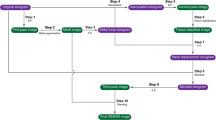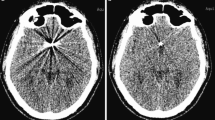Abstract
Purpose
This paper aims to evaluate a new iterative metal artifact reduction algorithm for post-interventional evaluation of brain tissue and intracranial arteries.
Methods
The data of 20 patients that underwent follow-up cranial CT and cranial CT angiography after clip** or coiling of an intracranial aneurysm was retrospectively analyzed. After the images were processed using a novel iterative metal artifact reduction algorithm, images with and without metal artifact reduction were qualitatively evaluated by two readers, using a five-point Likert scale. Moreover, artifact strength was quantitatively assessed in terms of CT attenuation and standard deviation alterations.
Results
The qualitative analysis yielded a significant increase in image quality (p = 0.0057) in iteratively processed images with substantial inter-observer agreement (ĸ = 0.72), while the CTA image quality did not differ (p = 0.864) and even showed vessel contrast reduction in six cases (30%). The mean relative attenuation difference was 27% without metal artifact reduction vs. 11% for iterative metal artifact reduction images (p = 0.0003).
Conclusions
The new iterative metal artifact reduction algorithm enhances non-enhanced CT image quality after clip** or coiling, but in CT-angiography images, the contrast of adjacent vessels can be compromised.



Similar content being viewed by others
References
Lanzino G, Murad MH, d’Urso PI, Rabinstein AA (2013) Coil embolization versus clip** for ruptured intracranial aneurysms: a meta-analysis of prospective controlled published studies. AJNR Am J Neuroradiol 34:1764–1768
Steiner T, Juvela S, Unterberg A et al (2013) European stroke organization guidelines for the management of intracranial aneurysms and subarachnoid haemorrhage. Cerebrovasc Dis 35:93–112
Cheng XQ, Chen Q, Zhou CS et al (2016) Whole-brain CT perfusion combined with CT angiography for ischemic complications following microsurgical clip** and endovascular coiling of ruptured intracranial aneurysms. J Clin Neurosci 26:50–56
Pechlivanis I, Konig M, Engelhardt M et al (2009) Evaluation of clip artefacts in three-dimensional computed tomography. Cent Eur Neurosurg 70:9–14
Zheng Y, Liu Y, Leng B, Xu F, Tian Y (2016) Periprocedural complications associated with endovascular treatment of intracranial aneurysms in 1764 cases. J Neurointerv Surg 8:152–157
Zhao B, Tan X, Yang H et al (2016) Endovascular coiling versus surgical clip** for poor-grade ruptured intracranial aneurysms: postoperative complications and clinical outcome in a multicenter poor-grade aneurysm study. AJNR Am J Neuroradiol 37:873–878
Kalender WA, Hebel R, Ebersberger J (1987) Reduction of CT artifacts caused by metallic implants. Radiology 164:576–577
Mangold S, Gatidis S, Luz O et al (2014) Single-source dual-energy computed tomography: use of monoenergetic extrapolation for a reduction of metal artifacts. Investig Radiol 49:788–793
Morsbach F, Wurnig M, Kunz DM et al (2013) Metal artefact reduction from dental hardware in carotid CT angiography using iterative reconstructions. Eur Radiol 23:2687–2694
Jia Y, Zhang J, Fan J et al (2015) Gemstone spectral imaging reduced artefacts from metal coils or clips after treatment of cerebral aneurysms: a retrospective study of 35 patients. Br J Radiol 88:20150222
Nute JL, Jacobsen MC, Chandler A, Cody DD, Schellingerhout D (2016) Dual-energy computed tomography for the characterization of intracranial hemorrhage and calcification: a systematic approach in a Phantom system. Investig Radiol 52:30–41
Aissa J, Boos J, Schleich C et al (2016) Metal artifact reduction in computed tomography after deep brain stimulation electrode placement using iterative reconstructions. Investig Radiol 52:18–22
Meyer E, Raupach R, Lell M, Schmidt B, Kachelriess M (2012) Frequency split metal artifact reduction (FSMAR) in computed tomography. Med Phys 39:1904–1916
Lell MM, Meyer E, Kuefner MA et al (2012) Normalized metal artifact reduction in head and neck computed tomography. Investig Radiol 47:415–421
Meyer E, Raupach R, Lell M, Schmidt B, Kachelriess M (2010) Normalized metal artifact reduction (NMAR) in computed tomography. Med Phys 37:5482–5493
Christner JA, Kofler JM, McCollough CH (2010) Estimating effective dose for CT using dose-length product compared with using organ doses: consequences of adopting international commission on radiological protection publication 103 or dual-energy scanning. AJR Am J Roentgenol 194:881–889
Bamberg F, Dierks A, Nikolaou K, Reiser MF, Becker CR, Johnson TR (2011) Metal artifact reduction by dual energy computed tomography using monoenergetic extrapolation. Eur Radiol 21:1424–1429
Weiss J, Schabel C, Bongers M et al (2016) Impact of iterative metal artifact reduction on diagnostic image quality in patients with dental hardware. Acta Radiol 58:279–285
Bier G, Bongers MN, Ditt H, Bender B, Ernemann U, Horger M (2016) Enhanced gray-white matter differentiation on non-enhanced CT using a frequency selective non-linear blending. Neuroradiology 58:649–655
Landis JR, Koch GG (1977) The measurement of observer agreement for categorical data. Biometrics 33:159–174
Prell D, Kyriakou Y, Struffert T, Dorfler A, Kalender WA (2010) Metal artifact reduction for clip** and coiling in interventional C-arm CT. AJNR Am J Neuroradiol 31:634–639
Liu PT, Pavlicek WP, Peter MB, Spangehl MJ, Roberts CC, Paden RG (2009) Metal artifact reduction image reconstruction algorithm for CT of implanted metal orthopedic devices: a work in progress. Skelet Radiol 38:797–802
Axente M, Paidi A, Von Eyben R et al (2015) Clinical evaluation of the iterative metal artifact reduction algorithm for CT simulation in radiotherapy. Med Phys 42:1170–1183
Wuest W, May MS, Brand M et al (2015) Improved image quality in head and neck CT using a 3D iterative approach to reduce metal artifact. AJNR Am J Neuroradiol 36:1988–1993
Brook OR, Gourtsoyianni S, Brook A, Mahadevan A, Wilcox C, Raptopoulos V (2012) Spectral CT with metal artifacts reduction software for improvement of tumor visibility in the vicinity of gold fiducial markers. Radiology 263:696–705
Bongers MN, Schabel C, Thomas C et al (2015) Comparison and combination of dual-energy- and iterative-based metal artefact reduction on hip prosthesis and dental implants. PLoS One 10:e0143584
Schabel C, Gatidis S, Bongers M et al (2016) Improving CT-based PET attenuation correction in the vicinity of metal implants by an iterative metal artifact reduction algorithm of CT data and its comparison to dual-energy-based strategies: a Phantom study. Investig Radiol 52:61–65
Higashigaito K, Angst F, Runge VM, Alkadhi H, Donati OF (2015) Metal artifact reduction in pelvic computed tomography with hip prostheses: comparison of virtual monoenergetic extrapolations from dual-energy computed tomography and an iterative metal artifact reduction algorithm in a Phantom study. Investig Radiol 50:828–834
Mahnken AH, Raupach R, Wildberger JE et al (2003) A new algorithm for metal artifact reduction in computed tomography: in vitro and in vivo evaluation after total hip replacement. Investig Radiol 38:769–775
Pierot L, Portefaix C, Boulin A, Gauvrit JY (2012) Follow-up of coiled intracranial aneurysms: comparison of 3D time-of-flight and contrast-enhanced magnetic resonance angiography at 3T in a large, prospective series. Eur Radiol 22:2255–2263
Author information
Authors and Affiliations
Corresponding author
Ethics declarations
Funding
No funding was received for this study.
Conflict of interest
The authors declare that they have no conflict of interest.
Ethical approval
All procedures performed in studies involving human participants were in accordance with the ethical standards of the institutional and/or national research committee and with the 1964 Helsinki declaration and its later amendments or comparable ethical standards.
Informed consent
For this type of retrospective study, formal consent is not required.
Rights and permissions
About this article
Cite this article
Bier, G., Bongers, M.N., Hempel, JM. et al. Follow-up CT and CT angiography after intracranial aneurysm clip** and coiling—improved image quality by iterative metal artifact reduction. Neuroradiology 59, 649–654 (2017). https://doi.org/10.1007/s00234-017-1855-6
Received:
Accepted:
Published:
Issue Date:
DOI: https://doi.org/10.1007/s00234-017-1855-6




